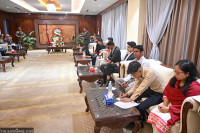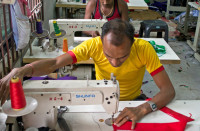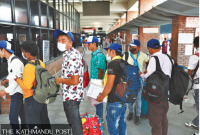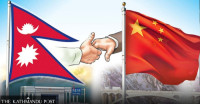Sat, Nov 1, 2025
Opinion
Trainspotting in Kathmandu
Road expansion alone will not solve traffic congestion; an urban rail might do better
bookmark
Binod L Amatya
Published at : February 27, 2014
Major roads in Kathmandu are currently being widened while some have already been expanded. The present four lanes of the Kalanki to Koteshwor segment of the Ring Road will soon be upgraded to eight lanes. Therefore, there is a growing expectation among people of soon experiencing a comfortable commute and a better urban environment in the Capital. However, it is difficult to ascertain if these improvements are part of the government’s strategic development plan and action as of now.
In order to meet the expectations of the people, authorities need to move beyond a patch and mend mentality. There is a need to develop long-term vision for the city’s transportation infrastructure and take bold actions to implement it. The current widening of roads is only a temporary solution that will never be able to solve traffic congestion. The city needs an infrastructure renaissance and this is possible only through the introduction of a new mode of public transport, such as an urban rail network. Such bold infrastructure projects are essential for sustainable growth and the long-term socio-economic well-being of the Capital.
When planning an urban rail network in the Capital, railway lines crossing the city are essential. Kathmandu needs rail routes running from East to West and North to South. This is particularly essential for the core city area within the Ring Road, which is the Central Activity Zone (CAZ) of the Capital and a Prime Opportunity Area (POA). Such connections are possible with the development of a network of railway tunnels beneath the city.
On-track in London
This, however, is not a new concept. A railway construction project in London, known as a crossrail, is based on a similar model. Upon completion in 2018, it is anticipated to revolutionise East-West transit in and across London. This project will increase London’s rail network capacity by 10 percent and boost city regeneration, significantly reduce travel time and offer better and easier interchange connections. After years of discussion and planning, this project finally received Royal Assent in 2008 and construction is on the way to provide additional but vital infrastructure to London’s public transport system. This project is 118km long with 37 stations, 21km of twin-bored tunnels of 6.2m internal diametre passing some 30m beneath Central London.
A crossrail is about more than just building tunnels and stations . The project is capable of breathing a new life into the city and driving the economy. Upon completion, the transport authority of London is planning a second new cross-city railway project, which will run on South-West to North-East alignments and will be officially known as Crossrail-2. This project is currently in its planning phase and has been proposed to be built by 2021.
The concept of transportation development to keep the city of London connected is very much applicable to the Kathmandu Valley. A Kathmandu line and a Patan line should be built as a Kathmandu crossrail for East-West and North-South transit. The Kathmandu line will connect the central part of the city, envisioned here at Bhrikuti Mandap with Kalanki in the West and Boudha and Koteshwor in the East. This Y-shape line will facilitate East-West transit. Similarly, the Patan line will connect Bhrikuti Mandap with Satdobato in the South and Bansbari in the North. This line will facilitate North-South transit.
These lines should be further extended outward from the CAZ, such as to Satungal in the West, Thecho in the South, Thimi and Gokarna in the East and Chunikhel in the North. As the city is expanding rapidly with an ever-increasing population, the network should also have the prospect of expanding outward. Also, a large station incorporating rail depot facilities will be difficult or expensive to manage in the core area. Thus, extending the lines to the growing suburbs or the greater Kathmandu area is essential. Meanwhile, such extension will also prevent over-congestion in the central activity zone.
Redesigning a city
An urban rail network is not just a transportation facility; it is also an instrument to restructure our city. The population within and around the Ring Road is estimated at two million and the whole Valley could be four to five million. The Valley’s population has increased by about one million in the last decade alone. So proper town areas can be built by extending the rail network to such places.
As the city is densely populated and the city roads and highways are very narrow, the railway network within and around the Ring Road can be built underground. This can be done by constructing twin-tunnels 4.5-5m in diameter at a minimum depth of about 20m below ground level. Kathmandu’s subsurface is predominantly composed of black silty clay, which is a very good medium for tunnelling. The principal interchange stations—such as those at Bhrikuti Mandap, Kalanki, Koteshwor, Boudha, Satdobato and Bansbari within the central area—will be underground and these can be built using a ‘cut and cover’ technique. Intermediate stations within the central area can be built by either enlarging the running tunnels and interconnecting them or using the same techniques adopted for the main stations.
The lines running outside the Ring Road can be built either on the ground surface or above ground in the form of an elevated railway track similar to the Bangkok Sky Train. And stations for these areas—such as at Satungal, Thecho, Thimi, Gokarna and Chunikhel—can be built over-ground by using normal building construction techniques.
Planning for the future
Kathmandu will continue to grow. The prime opportunity area will continue to expand with many offices, institutions, hospitals already being established in the greater Kathmandu area. So the fragmental implementation of road-widening projects will not alleviate traffic congestion in the long term. An urban rail network as a means of delivering sustainable transport should be foremost in the government’s transport strategy. In this regard, a crossrail in Kathmandu is vital to help regenerate the city, tackle congestion and urban pollution and keep the Capital ‘healthy’.
So it is recommended that a detailed study of the proposed routes be carried out by the relevant government authority urgently to safeguard rail routes and station development sites at the earliest. Doing so will secure the future of the Capital.
Amatya is a consulting geotechnical engineer currently practicing in the UK
Editor's Picks
E-PAPER | November 01, 2025
×




 19.12°C Kathmandu
19.12°C Kathmandu










